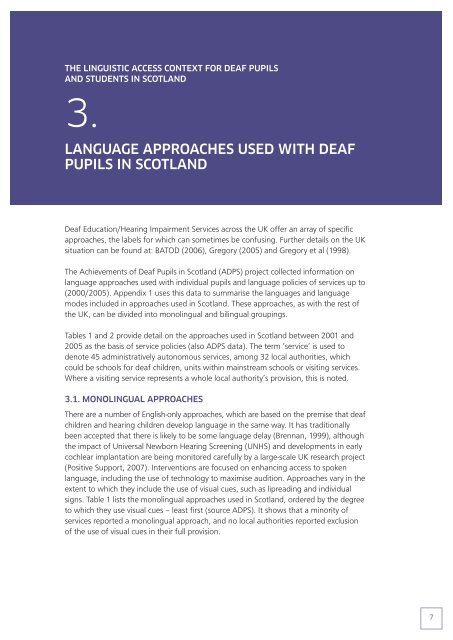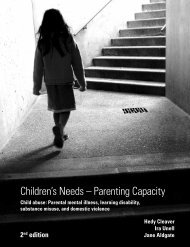British Sign Language and Linguistic Access Working Group ...
British Sign Language and Linguistic Access Working Group ...
British Sign Language and Linguistic Access Working Group ...
Create successful ePaper yourself
Turn your PDF publications into a flip-book with our unique Google optimized e-Paper software.
THE LINGUISTIC ACCESS CONTEXT FOR DEAF PUPILSAND STUDENTS IN SCOTLAND3.LANGUAGE APPROACHES USED WITH DEAFPUPILS IN SCOTLANDDeaf Education/Hearing Impairment Services across the UK offer an array of specificapproaches, the labels for which can sometimes be confusing. Further details on the UKsituation can be found at: BATOD (2006), Gregory (2005) <strong>and</strong> Gregory et al (1998).The Achievements of Deaf Pupils in Scotl<strong>and</strong> (ADPS) project collected information onlanguage approaches used with individual pupils <strong>and</strong> language policies of services up to(2000/2005). Appendix 1 uses this data to summarise the languages <strong>and</strong> languagemodes included in approaches used in Scotl<strong>and</strong>. These approaches, as with the rest ofthe UK, can be divided into monolingual <strong>and</strong> bilingual groupings.Tables 1 <strong>and</strong> 2 provide detail on the approaches used in Scotl<strong>and</strong> between 2001 <strong>and</strong>2005 as the basis of service policies (also ADPS data). The term ‘service’ is used todenote 45 administratively autonomous services, among 32 local authorities, whichcould be schools for deaf children, units within mainstream schools or visiting services.Where a visiting service represents a whole local authority’s provision, this is noted.3.1. MONOLINGUAL APPROACHESThere are a number of English-only approaches, which are based on the premise that deafchildren <strong>and</strong> hearing children develop language in the same way. It has traditionallybeen accepted that there is likely to be some language delay (Brennan, 1999), althoughthe impact of Universal Newborn Hearing Screening (UNHS) <strong>and</strong> developments in earlycochlear implantation are being monitored carefully by a large-scale UK research project(Positive Support, 2007). Interventions are focused on enhancing access to spokenlanguage, including the use of technology to maximise audition. Approaches vary in theextent to which they include the use of visual cues, such as lipreading <strong>and</strong> individualsigns. Table 1 lists the monolingual approaches used in Scotl<strong>and</strong>, ordered by the degreeto which they use visual cues – least first (source ADPS). It shows that a minority ofservices reported a monolingual approach, <strong>and</strong> no local authorities reported exclusionof the use of visual cues in their full provision.7
















